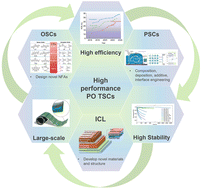Opportunities and challenges in perovskite–organic thin-film tandem solar cells
Abstract
Efficiency is paramount in enhancing the performance and cost-effectiveness of solar cells. Recent advancements in single-junction perovskite solar cells (PSCs) have yielded an impressive efficiency of 26.1%, nearing their theoretical limit. Meanwhile, multi-junction tandem solar cells exhibit a remarkable efficiency potential exceeding 42%, surpassing the 33% limit of single-junction cells, thereby opening avenues for ultra-high-efficiency solar cells. Tandem solar cells (TSCs) represent a groundbreaking photovoltaic technology, offering high efficiency, low cost, and a simple fabrication process. Among various TSCs, perovskite–organic TSCs (PO TSCs) are particularly promising due to their ability to leverage the complementary strengths of PSCs and organic solar cells (OSCs). PO TSCs are poised to outperform existing TSCs in terms of device performance, manufacturing cost, and diverse applications. The introduction of Y6-series non-fullerene acceptors (NFAs) over the past three years has significantly advanced the development of OSCs, leading to remarkable progress in PO TSCs. This paper commences by elucidating the advantages and potential of OSCs as bottom sub-cells in PO TSCs, followed by an in-depth review of mainstream interconnection layer (ICL) design. It then addresses key challenges in wide bandgap PSCs, including phase segregation, photovoltage loss, energy loss, and long-term stability. The paper concludes by examining critical factors influencing the future development of PO TSCs.

- This article is part of the themed collections: Recent Review Articles and Nanoscale 2024 Emerging Investigators


 Please wait while we load your content...
Please wait while we load your content...